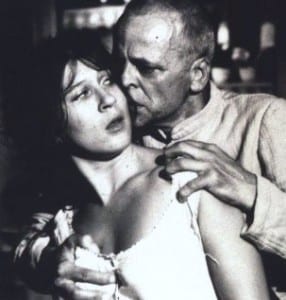On this part of the blog I will be describing the process that I have gone through to get my version of the character Woyzeck. Starting from my first initial ideas about how I could play the character, how those have developed and how I aim to develop them further.
At first when the play Woyzeck was described to me (before reading it), I had the idea that the character Woyzeck would have the characteristics of a twitchy nervous mental patient (similar to the kind Brad Pitt plays in Twelve Monkeys film) and having such character traits as fast head twitches and jolts, big wide eyes and lots of fidgeting. I had this first initial idea because the description of the character that was given to me described him as mentally unstable and somewhat scary.
After the first read through I understood more what Woyzeck had to go through, for instance; his wife cheats on him and doctors doing experiments on him. This gave me a much clearer idea of what Woyzeck would be like. I think he would be less likely to twitch and fidget, as this would show a sort of deranged person, but more likely to stand and stare off into space on a regular basis and loose all concentration.
I found this recording of a contemporised performance of Woyzeck. I think this is a great example of how NOT to do it. (Despite the terrible acting) I think that the Woyzeck tries to jump from being funny to being scared and jumpy, which does not work at all. It’s clear from this performance that the script is a very delicate thing. Also it’s clear that the audience perception is delicate if the actor’s intentions are not clear. Jumping from trying to be funny to trying to gain sympathy from the audience is not going to work. It plays too much with the audience and leaves them unaware of whether they should be laughing at or feeling sorry for Woyzeck.
I noticed after watching this Youtube video of how that theatre company tried to perform Woyzeck, that the character Woyzeck is fragile. Fragile in the sense of the audience interpretations of him, if it’s not made clear Woyzeck’s emotion then it will mess the whole performance up. I from this point made it my mission to ensure that the audience’s interpretation of Woyzeck is that he is being destroyed from the outside in. as hard as it is for me to not make things funny or to might light out of situations, I didn’t want to make Woyzeck funny. I’ve grown to truly understand the torture that Woyzeck is feeling and the only laughing the audience would be doing towards Woyzeck would be awkward laughing, because are not sure about how else to act.
